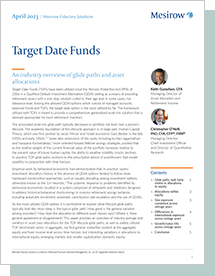Target Date Funds
Share this article
by Keith Gustafson, CFA and Christopher M. O'Neill, PhD, CFA, CFP®, FRM®, ChFC®
An industry overview of glide paths and asset allocations
Target Date Funds (TDFs) have been utilized since the Pension Protection Act (PPA) of 2006 in a Qualified Default Investment Alternative (QDIA) setting as a means of providing retirement savers with a one-stop solution suited to their age and, in some cases, risk tolerance level. Among the allowed QDIA options which consist of managed accounts, balanced funds and TDFs, the target date option is the most utilized by far. The framework utilized with TDFs is meant to provide a comprehensive, generalized asset mix solution that is deemed appropriate for most retirement investors.
The associated asset mix glide path typically decreases in portfolio risk level over a person’s lifecycle. The academic foundation of this lifecycle approach is, in large part, Human Capital Theory, which was first posited by Jacob Mincer and Nobel economist Gary Becker in the late 1950s and early 1960s.1,2 Some later extensions of this work, including by Ravi Jagannathan and Narayana Kocherlakota,3 more oriented toward lifetime savings strategies, posited that as the relative weight of the current financial value of the portfolio increases relative to the present value of future human capital, the ability to weather volatility shocks declines. In practice, TDF glide paths conform to the prescriptive advice of practitioners that model volatility in conjunction with time horizon.
Empirical work by behavioral economists had demonstrated that, in practice, savers’ investment allocation choices in the absence of QDIA options tended to follow more haphazard construction approaches, such as equally allocating among investment options, otherwise known as the 1/n heuristic.4 The systemic response to problems identified by behavioral economists resulted in a system comprised of stimulants and stabilizers designed to address historical behavioral shortcomings in investor retirement savings behavior, including automatic enrollment, automatic contribution rate escalation and the use of QDIAs.
As the most utilized QDIA option, it is worthwhile to explore what lifecycle glide paths typically look like: How steep is the typical glide path? How great is the general variation among providers? How does the allocation to different asset classes vary? Where is there general agreement or disagreement? This paper provides an overview of industry average and variation in asset class allocations for the TDF lifecycle glide paths, as well as widely utilized TDF benchmark series. In aggregate, we find general similarities evident at the aggregate equity and fixed income level across time horizon, but interesting variations in allocations to international equity, emerging markets and smaller capitalization domestic equity.

Mesirow refers to Mesirow Financial Holdings, Inc. and its divisions, subsidiaries and affiliates. The Mesirow name and logo are registered service marks of Mesirow Financial Holdings, Inc. ©2025, Mesirow Financial Holdings, Inc. All rights reserved. Any opinions expressed are subject to change without notice. Past performance is not indicative of future results. Advisory Fees are described in Mesirow Financial Investment Management, Inc.’s Form ADV Part 2A. Advisory services offered through Mesirow Financial Investment Management, Inc. an SEC registered investment advisor. Securities offered by Mesirow Financial, Inc. member FINRA and SIPC.
